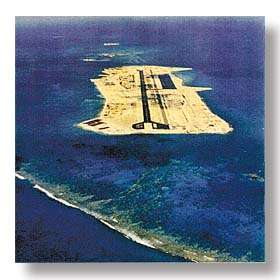LIHU’E – The plutonium in the lagoon, coral, sand and construction debris on Johnston Atoll does not pose a military, human or environmental threat, the U.S. military believes. Birds nest in some of the concrete debris slated for permanent disposal
LIHU’E – The plutonium in the lagoon, coral, sand and construction debris on Johnston Atoll does not pose a military, human or environmental threat, the U.S. military believes.
Birds nest in some of the concrete debris slated for permanent disposal either on the tiny island or at a mainland facility. People snorkel and scuba dive in the lagoon, and eat fish from the teeming surrounding waters.
The process to extract the plutonium from the coral and debris to make weapons of mass destruction doesn’t really exist.
So why does the Defense Threat Reduction Agency (DTRA) want to clean up the atoll, which is more than 700 miles from Hawai’i?
“It’s the responsible thing to do,” said Maj. David Rynders of DTRA, out of Kirtland Air Force Base in New Mexico.
Cleanup efforts thus far have been more than satisfactory to the U.S. Environmental Protection Agency, which noted in a letter that DTRA had voluntarily adopted a more stringent standard for exposure to radioactivity.
In 1962, two failed missile tests dumped radioactive plutonium around the atoll. Cleanup efforts have continued since then.
A final disposal plan for what the military believes is the worst contamination still known to exist on the island is in the works, and was the subject of a public availability meeting Monday at the Lihu’e Public Library. Only about 10 Kauaians showed up, mostly to ask questions about the process.
After more public meetings on the Hawai’i islands, a scoping meeting, including a public comment period, was set for today in Honolulu.
There is life are on Johnston Atoll, where a chemical and nuclear weapons disposal facility was closed down last year. Around 1,000 people live and work there, and Aloha Airlines flies to the atoll each week.
The residents perform support services (food service, water, wastewater treatment, etc.) for the military and civilian contractors. The U.S. Fish and Wildlife Service, which intends to remain on the island after most of the other tenants have left, has a presence there now.
The DTRA cleanup is focused on 24 acres of the atoll known as the Radiological Control Area (RCA), where most of the contaminated soils, coral and debris has been collected.
Exposure level DTRA believes achievable equates to less than that received from one X-ray at the dentist, according to officials.
A pile of coral soil above DTRA’s acceptable limits is proposed to be disposed of in a landfill at Johnston with various landfill configurations, or shipped to the mainland for final disposal.
The mainland option would bring the contaminated material first to Honolulu, where the shipment would clear customs before sailing for a California port and then going by rail or truck to disposal sites in Utah or Nevada, Rynders explained.
Inhaling plutonium would do the most harm to humans and wildlife. Their bodies have enough defense mechanisms to prevent the debris from getting into lungs where it could do the most permanent damage, he said.
Also, the pieces of debris which are known to contain plutonium are for mostly too large to be a respiratory threat, Rynders said.
A period for written public comment on various disposal plans (including a no-action option) runs through June 15. Comments can be sent to DTRA, 8725 John J. Kingman Rd. MSC 6201, Fort Belvoir, Va. 22060-6201.
It will be some time before a decision is made, as input must also be collected and digested by the EPA and the Fish and Wildlife Service.
According to Harry Stumpf, a senior environmental engineer with DTRA, the plan doesn’t require an environmental impact statement because the process involved – preparation of a defense environmental document – takes environmental factors into consideration in a more thorough way than an EIS.
Also, since the intent is to clean up an environmental mess, the environmental impacts are only anticipated to be positive, officials said.
Johnston Atoll, long known in Hawai’i as Kalama, sits approximately 717 nautical miles west-southwest of O’ahu. In 1940, Johnston consisted of one island with a land mass 60 acres in size surrounded by its reefs and waters. Now it is over 600 acres, the result of dredging and other buildup efforts.
It has held significant military importance over the years.
Redistributing coral around the islands for contamination control and expanding the island, according to cleanup officials, compounded contamination problems. Some contaminated land materials were moved into the lagoon for construction and expansion, and tons of dredged coral most likely contaminated from the first failed test was brought onto land to cover the areas that had been most highly contaminated.
Those critical of the cleanup efforts have also asked why the radiological survey is limited to surface testing only, and has not included subsurface testing.
Staff Writer Paul C. Curtis can be reached at mailtoa;pcurtis@pulitzer.net or 245-3681 (ext. 224).


